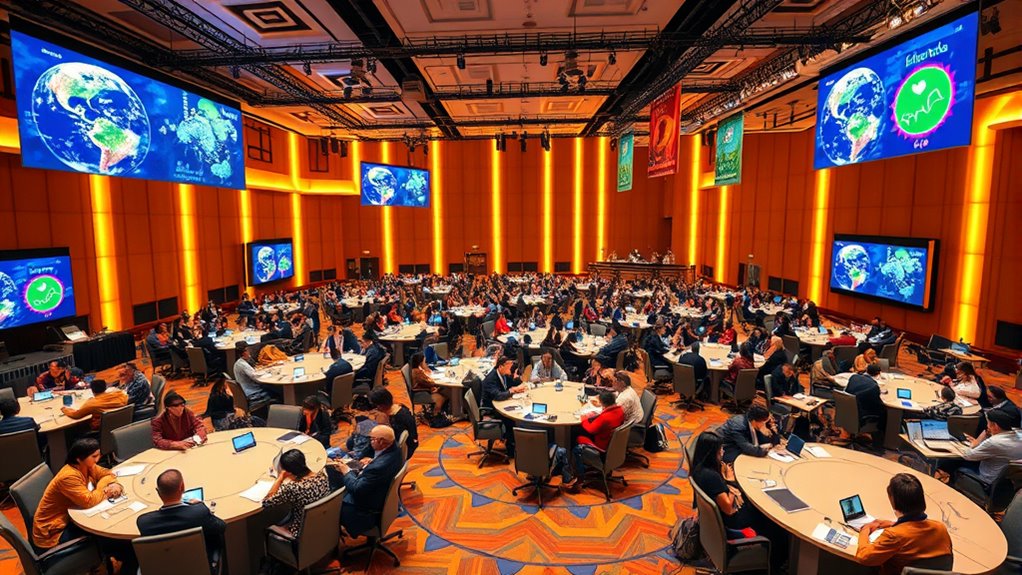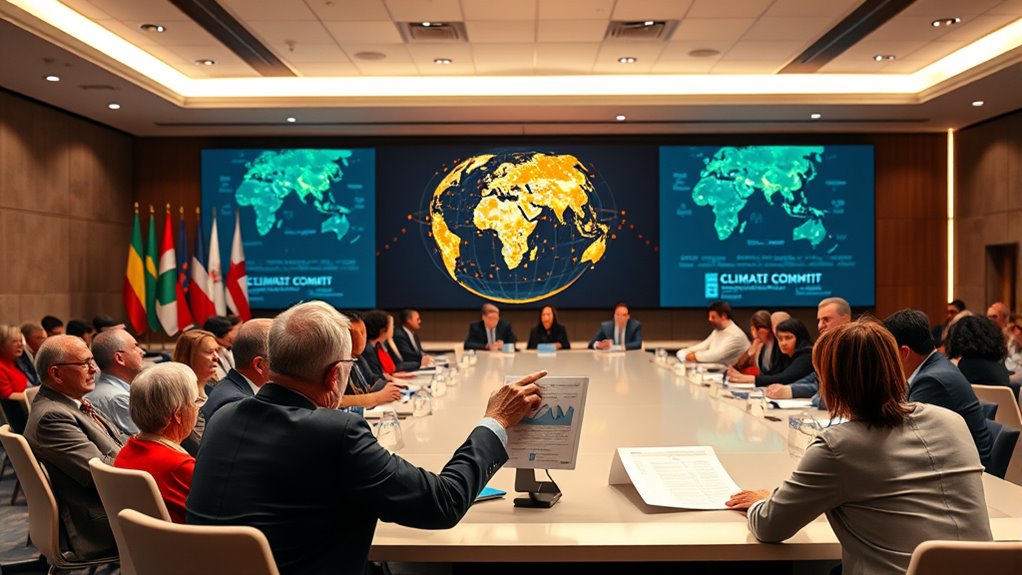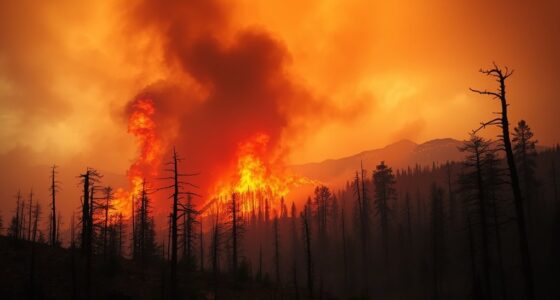At COP30, key takeaways focus on speeding up the switch to renewable energy sources like wind and solar, which are essential for fighting climate change. Leaders also pledged more climate finance to help vulnerable communities adapt and shift. These commitments aim to create cleaner, resilient energy systems and foster innovation. If you want to understand how these actions could shape a sustainable future, keep exploring the summit’s impactful solutions and long-term goals.
Key Takeaways
- The summit emphasizes accelerating the global shift to renewable energy sources like wind and solar.
- Increased climate finance commitments aim to support vulnerable communities and develop sustainable projects.
- Funding is crucial to deploying renewable technologies, creating jobs, and fostering innovation worldwide.
- Immediate, practical actions are prioritized to implement renewable solutions and strengthen climate resilience.
- The summit highlights the interconnected roles of technology, finance, and policy in achieving climate goals.

The COP30 Climate Summit brings together world leaders, scientists, and activists to tackle the urgent challenge of climate change. As you follow the discussions, it’s clear that shifting to renewable energy sources is at the heart of many commitments. Countries are being urged to accelerate the transition from fossil fuels to wind, solar, and other sustainable options. This shift isn’t just about reducing emissions; it’s about creating a resilient energy system that can sustain future generations. You can expect the summit to emphasize how renewable energy is essential for achieving global climate goals, helping nations cut their carbon footprints while boosting economic growth through green industries.
A major focus of COP30 is climate finance—funds allocated to support climate action, especially in vulnerable communities. You’ll hear leaders pledge more funding to help developing countries adapt to climate impacts and move to cleaner energy sources. This financial backing is critical because many nations lack the resources needed to implement large-scale renewable projects or safeguard their populations from climate-related disasters. The summit aims to mobilize billions of dollars, fostering partnerships between governments, private investors, and international organizations. You’re encouraged to see how climate finance isn’t just about charity; it’s an investment in stability and sustainable growth for the future.
As you absorb the summit’s developments, it’s evident that the integration of renewable energy and climate finance is interconnected. Without sufficient funding, the adoption of renewable technologies stalls, and climate resilience remains elusive. Conversely, investing in renewable infrastructure creates economic opportunities and job growth, making climate finance a smart, long-term investment. Leaders are recognizing that bold commitments on finance can open doors to innovation, helping communities leapfrog fossil fuels directly to cleaner alternatives. You’re also likely to notice discussions about transparency and accountability, ensuring that funds are used effectively and reach the communities that need them most.
Throughout COP30, the message is clear: addressing climate change requires immediate action and sustained effort. The commitments around renewable energy and climate finance are steps toward a more sustainable and equitable future. You’re encouraged to see that these initiatives aren’t just policies on paper—they’re practical solutions that can be implemented now. As the summit concludes, you’ll want to stay informed and advocate for continued investments in renewable energy and climate finance, knowing that these are key to safeguarding the planet for generations to come. Additionally, advancements in AI tools are increasingly supporting data analysis and decision-making processes at summits like COP30, enhancing the effectiveness of climate strategies.
Frequently Asked Questions
How Will COP30 Impact Local Communities Most Affected by Climate Change?
COP30 will boost your community’s resilience by emphasizing local adaptation strategies. You’ll see more funding and support for initiatives that address your specific climate challenges. This summit encourages governments and organizations to prioritize your needs, helping you develop sustainable solutions. As a result, your community can better withstand climate impacts, protect your environment, and improve overall well-being through targeted actions and increased collaboration.
What New Technologies Were Showcased at COP30 for Climate Mitigation?
Like Prometheus stealing fire, you see new technologies at COP30 that ignite hope for our future. You’re introduced to cutting-edge renewable innovations, such as advanced solar panels and green hydrogen solutions, designed to accelerate emission reduction. These breakthroughs promise to transform energy systems, making them cleaner and more sustainable. By embracing these innovations, you’re taking active steps toward a healthier planet, ensuring that future generations inherit a more resilient Earth.
How Are Indigenous Voices Integrated Into COP30 Negotiations?
You see that indigenous voices are actively integrated into COP30 negotiations through a focus on respecting Indigenous sovereignty and valuing traditional knowledge. Delegates listen to Indigenous representatives, ensuring their perspectives influence climate policies. This approach helps incorporate centuries-old sustainable practices into global strategies, fostering respect and collaboration. By amplifying these voices, COP30 aims to create more inclusive, effective solutions that honor Indigenous contributions to climate resilience and environmental stewardship.
What Are the Long-Term Financial Commitments Made at COP30?
You might think climate finance promises are vague, but at COP30, long-term funding commitments are clear. Countries pledged billions to support developing nations, aiming to boost climate resilience and renewable projects. These funding commitments show a real effort to address climate change. By backing up promises with financial support, negotiators demonstrate their dedication to a sustainable future, ensuring that climate finance remains a priority for years to come.
How Does COP30 Address Climate Justice and Equity Issues?
At COP30, you see a strong focus on climate equity and social justice, ensuring vulnerable communities aren’t left behind. The summit promotes fair distribution of resources and decision-making power, addressing disparities caused by climate change. By prioritizing marginalized groups, COP30 fosters inclusive solutions that empower all nations, especially those most affected, working towards a more just and equitable global response to climate challenges.
Conclusion
As you reflect on COP30, remember that global commitments are crucial—yet only 45% of countries have set clear emission reduction targets. This summit highlights the urgent need for collective action to protect our planet’s future. Every effort counts, and your support can drive change. Together, we can turn these discussions into tangible results, ensuring a healthier Earth for generations to come. The future depends on what we do today.









